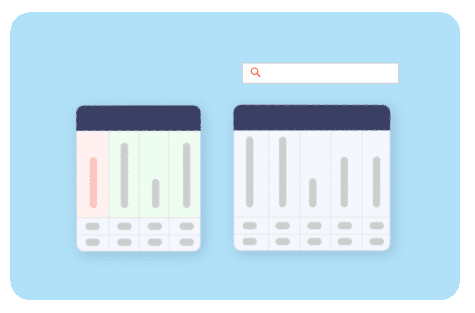How content marketing can upgrade your lead generation
In this blog
- Content marketing and multichannel marketing
- Creating content that converts
- How to create high-quality content
- How to optimise content for sales emails
- How to optimise content for search engines (SEO)
- How to optimise content for the sales cycle
- How to promote and distribute content
- Get your content in front of the right audience

Why you need content marketing as part of your lead generation strategy, how to create high-quality content, and the best ways to distribute and promote your words.
————————————————————————————————————————
Many marketers instinctively link content marketing with SEO, blogs, and websites: methods traditionally viewed as long-term lead gen strategies. But in reality, every marketing method has content at its core.
From PPC ads and landing pages to prospecting emails, outbound channels also need great content to resonate with and captivate your target audience.
And virtually every outbound marketing channel you deploy will, in one way or another, funnel traffic back to your website. As well as browsing your site, they might subscribe to your newsletter or connect with your social media accounts. And what awaits them in these spaces? Yet more content.
It’s not just the content your marketing team put out, either. If your sales team are reaching out to prospects – whether it’s via email, social media or phone calls – your prospects are likely to do a quick Google stalk. And if their LinkedIn profile is full of content that displays their knowledge and expertise, it gives them credibility.
Content marketing and multichannel marketing
In the age of multichannel marketing, having high-quality content that is consistent across your channels will help drive leads.
Think about it: consumers are hopping from one channel to another. And while each has its unique content requirements and audience expectations, you need to find consistency within the differences. This keeps your brand’s identity and voice on point, and acts as a powerful driver of leads.
So, whether you’re crafting a killer sales email, designing an eye-catching display ad, or an insightful blog post, every piece of content you put out there needs to work together to not only draw people in but also engage and convert them.
Creating content that converts
Content isn’t about churning out words; it’s about crafting a narrative that addresses pain points, educates with finesse, and sparks a genuine connection.
From educational blog posts and informative whitepapers, your content arsenal becomes a bridge – one that leads potential clients from curiosity to conversion.
How to create high-quality content
Let’s get into the nitty-gritty of crafting content that not only grabs attention, but generates new business from it.
1. Focus on relevance and value
Your audience isn’t looking for some words to fill their day – they’re on a quest for solutions that address their challenges and aspirations.
To craft content that truly resonates, start by understanding your target market inside out. What keeps them up at night? What are their goals and pain points? Armed with this knowledge, you can tailor your content to provide actionable insights, practical tips, and expert perspectives.
2. Use your buyer personas
Your buyer personas are a key part of your content toolkit. These personas aren’t just fictional profiles; they’re windows into the minds of your ideal clients. From job roles and pain points to goals and preferences, each detail informs the type of content that will resonate most.
Whether you’re addressing the CSO’s bottom-line concerns or the CMO’s creative visions, tailoring your content to specific personas creates an instant rapport. It’s like anticipating their needs before they even voice them.
3. Utilise different content formats
In a world where attention spans are fleeting at best, versatility is your content’s greatest ally. Breathe life into your ideas through a variety of mediums: from detailed blog posts and visually captivating infographics to immersive podcasts and bite-sized videos.
Each format has its unique allure, catering to diverse audience preferences and consumption habits. Some crave the written word’s depth, while others thrive on the visual feast of videos. And the best part? You can repurpose existing content into various different formats, working smarter and making your stuff go further.
By having a diverse range of content formats, you’re not just accommodating various learning styles – you’re casting a wider net, capturing the attention of leads that might have slipped through the cracks otherwise. So, gear up to tell your story in a multitude of ways, and watch your B2B lead generation strategy flourish across the spectrum.
4. Tell stories
Amidst a flurry of statistics and industry jargon, one element stands out as a timeless beacon of human connection: storytelling.
When woven seamlessly into your B2B lead generation content, stories have the power to transcend facts and figures, resonating deep within your audience’s psyche. Whether it’s the tale of a company’s triumphant journey or a client’s transformative experience, narratives breathe life into your brand, making it relatable and memorable.
Stories evoke emotions, stir empathy, and create a lasting bond – all essential ingredients for cultivating trust in the world of business.
5. Leverage data and statistics for credibility
Backing your claims with solid numbers isn’t just about impressing your audience – it’s about demonstrating your commitment to accuracy and informed decision-making. When you pepper your content with well-sourced data, you’re not just a voice; you’re a trustworthy guide navigating the complex landscape of industry trends and insights.
Be it the latest market research or a compelling case study, data-driven content reinforces your expertise and positions your brand as a thought leader worth following. So, wield those statistics wisely, and watch your content resonate with the discerning minds of B2B decision-makers.

View live Sopro campaign results
We publish all of our results and update them daily. Every client campaign. Every email.
See the data6. Use images, graphics, and videos effectively
A picture truly is worth a thousand words – and then some. Visual content such as images, graphics, and videos can transform your B2B lead generation content transforms into something that grabs attention.
Whether it’s an infographic that simplifies complex concepts or a video unveiling the inner workings of your product, visuals break the monotony of text, delivering information in a format that’s easy to digest and hard to forget.
How to optimise content for sales emails
So content can drive your outbound lead generation, and what better way to do that than email? After all, 77% of B2B buyers prefer suppliers to contact them via email. (For more lead generation statistics, or for the ultimate guide to B2B lead generation, read our tailored blogs.)
Writing a prospecting email that elicits a positive response is a subtle art underpinned by strategic thinking. It’s about striking a balance between being personable and professional, creative and concise. Here’s a guide to help you navigate through the process effectively.
- A quick, personal note
Craft your email as if you’re writing to a specific individual, not a mass audience. Personalize where possible, but ensure it’s done accurately and appropriately.
Imagine you have a short time to write a quick note to a potential prospect you just found on LinkedIn. Your email should read like a personal, spontaneous message, not like a generic, mass-sent campaign.
- An engaging subject line
The subject line is your first impression; make it count. Avoid generic greetings and craft a subject line that is personal and human. It should spark curiosity and intrigue, prompting the recipient to open the email.
- A clear value exchange
Clearly articulate the value the prospect will gain from engaging with you. Present a value proposition that addresses their challenges or needs, offering a tangible benefit in exchange for their time and attention.
Your prospect is being asked to spend their time on your email, and eventually on a call too. What’s in it for them?
- A structured email template
Structure your email with sections that each serve a specific purpose.
After your greeting, add a human introduction to soften them up. Then clearly state the reason for contact and logically explain the next steps. End with a call to action and a professional signature that doesn’t scream, “I’m a salesperson!”.
Each section should be concise and contribute to the overall message.
- Simple language
Use concise, straightforward language that a broad audience can understand. Avoid jargon and complex words. The tone should be professional yet approachable, making the recipient feel valued and respected.
To dive deeper into a little email and content in this webinar, with Steve Harlow, Sopro’s Chief Sales Officer and Kathryn Strachan, MD at Copy House.
How to optimise content for search engines (SEO)
And what about the long game? SEO is an effective and relatively cheap way of getting in front of the right people, but only if you bring your A game. It’s a complex field with a lot to learn, but here’s some tips to get you started.
1. Incorporate relevant keywords and phrases
Keywords. They’re the magic words that help your website show up when someone’s looking for things related to your product/service. But it’s not just about stuffing your content with keywords; it’s about integrating them seamlessly and organically.
Start by understanding the language your audience speaks – the words they type into search bars when seeking answers. Then, strategically sprinkle these keywords and phrases throughout your content, from headlines to body text, and even in image alt tags.
But remember, you’re writing for humans first, and search engines second. Your content should read naturally while also signalling to search engines that it’s a relevant match for specific queries.
2. Write compelling meta titles and descriptions
Think of meta titles and descriptions as helpful previews of your content in search results. Crafting them with finesse is your chance to hook potential readers before they click through.
Your meta title should summarise the essence of your content, entwining relevant keywords while evoking curiosity. Meanwhile, the meta description is your elevator pitch – a concise yet compelling snippet that promises value.
By infusing your metadata with clarity and relevance, you’re not just optimising for search engines; you’re enticing real people to give your content their click.
3. Build backlinks to improve search rankings
Backlinks are the bridges that connect your content to the rest of the internet. Backlinks are links from external websites to your website, and having them signals to search engines that your content is a trusted resource, boosting your credibility and authority.
But not all backlinks are created equal – quality trumps quantity. Seek out authoritative websites in your industry and collaborate on guest posts, thought leadership contributions, or even expert interviews. Each link serves as a vote of confidence in your content’s worthiness, propelling your search rankings higher.
Remember: it’s not just about forging connections; it’s about weaving a digital network that elevates your content’s stature in the eyes of both algorithms and readers.
4. Optimise content for mobile devices
In the era of thumb-scrolling and on-the-go browsing, the mobile experience can make or break your content’s success. Optimising for mobile devices isn’t just a nicety; it’s a necessity.
From responsive design that adapts seamlessly to various screen sizes to fast-loading pages that don’t test users’ patience, every aspect counts. Think clean layouts, legible fonts, and easily tapable buttons.
Google’s mobile-first indexing also prioritises mobile-friendly content, impacting your search rankings. So by making your content a joy to consume on smartphones and tablets, you’re not just catering to a growing user base; you’re also enhancing your content’s discoverability and engagement potential.
How to optimise content for the sales cycle
There’s an art to aligning your content with the buyer’s journey. That’s why each phase of the sales funnel demands a unique content approach. Here’s how to craft content that not only educates but also nudges prospects closer to conversion.
1. Content for the “awareness” stage (top of the funnel)
In the initial stages, focus on creating content that generates awareness and sparks curiosity. At the top of the funnel, your content should be like the intriguing window display that catches the eye – it’s about creating awareness and sparking interest. Think insightful blog posts, engaging social media content, and informative infographics.
2. Content for the “consideration” stage (middle of the funnel)
As leads progress down the funnel, the content shifts focus. Transition to content that educates and addresses their specific challenges. Now, it’s about providing in-depth value and addressing specific pain points. Whitepapers, webinars, and detailed case studies take centre stage.
3. Content for the “decision” stage (bottom of the funnel)
Finally, as they near the decision phase, offer content that solidifies trust, showcases your expertise, and nudges them towards the final action. Evidence how your solution aligns with their unique needs with content like social proof, product comparisons, and client case studies.
4. Content for closing deals (sales enablement)
Sales enablement content empowers your sales team to guide prospects through the final stretch of the buying journey. Think of it as a toolkit stocked with resources to arm your salespeople with the insights, data, and materials they need to close deals effectively.
Whether it’s persuasive pitch decks that highlight benefits or objection-handling guides that preemptively address concerns, by providing your sales team with the ammunition they require, content becomes an active part of the sales process.

The complete guide to B2B sales strategies
A complete deep-dive into what sales strategies are, the different types and how to implement your own.
Read the guideHow to promote and distribute content
Creating great content that works for all stages of the sales journey is just one half of the battle. You need a plan for how the fruits of your labour meet the eager eyes of your target audience. Here are a few of the best ways you can promote and distribute your content:
1. Use social media for content promotion
Social media platforms have emerged as the modern-day town square, bustling with conversations, connections, and opportunities. Leveraging these platforms for content promotion isn’t just a strategy; it’s a necessity.
Craft attention-grabbing headlines, pair them with eye-catching visuals, and strategically time your posts to capture maximum engagement. Engage with your audience by responding to comments, initiating discussions, and fostering a sense of community.
2. Leverage email to nurture leads
Email is a versatile tool that isn’t just about sending occasional updates; it’s a strategic way to nurture leads, build relationships, and convert interest into action.
Craft personalised email campaigns that speak directly to the needs and pain points of your audience. Segmentation is your guiding star – tailor content to where leads are in their journey.
3. Utilise digital PR for credibility and online real estate
Leveraging digital PR for content distribution can significantly amplify your reach and impact. Media outlets are always looking for unique perspectives on trending topics, so promote content that has a strong new hook and distinctive angle.
Research journalists, bloggers, and influencers who cover topics related to your content. Then follow them on social media, engage with their content, and build a rapport so that when you push your content out there, they’ll me more likely to pick it up. It’s not just about promoting your content, but also becoming a trusted source of information in your industry.
4. Collaborate with influencers and partners for wider reach
By teaming up with industry influencers or complementary businesses, you’re able to tap into their established networks and credibility, instantly expanding your content’s reach.
The key lies in finding partners whose values align with yours and whose audiences stand to benefit from your offerings. As you join forces, your content gains an extended life, reaching eyes and ears that might have remained untouched otherwise.
Get your content in front of the right audience
Crafting compelling content is the first step, but ensuring it reaches the right eyes and ears is where the true art lies. In today’s noisy market, B2B customers are bombarded with endless content. So, to win them over, you’ve got to stand out and forge real connections.
If you want to grab attention and generate leads, it’s time to say hello to Sopro. Our experts will strategically position your offering and engage with ideal customers on your behalf, ensuring you send the perfect message to the right audience exactly when they need it.
Say goodbye to slow sales months: bring in Sopro’s lead generation services, and you could start getting hot leads in as little as two weeks.






Share